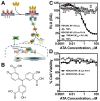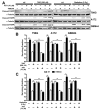Identification of aurintricarboxylic acid as a selective inhibitor of the TWEAK-Fn14 signaling pathway in glioblastoma cells
- PMID: 28103571
- PMCID: PMC5355340
- DOI: 10.18632/oncotarget.14685
Identification of aurintricarboxylic acid as a selective inhibitor of the TWEAK-Fn14 signaling pathway in glioblastoma cells
Abstract
The survival of patients diagnosed with glioblastoma (GBM), the most deadly form of brain cancer, is compromised by the proclivity for local invasion into the surrounding normal brain, which prevents complete surgical resection and contributes to therapeutic resistance. Tumor necrosis factor-like weak inducer of apoptosis (TWEAK), a member of the tumor necrosis factor (TNF) superfamily, can stimulate glioma cell invasion and survival via binding to fibroblast growth factor-inducible 14 (Fn14) and subsequent activation of the transcription factor NF-κB. To discover small molecule inhibitors that disrupt the TWEAK-Fn14 signaling axis, we utilized a cell-based drug-screening assay using HEK293 cells engineered to express both Fn14 and a NF-κB-driven firefly luciferase reporter protein. Focusing on the LOPAC1280 library of 1280 pharmacologically active compounds, we identified aurintricarboxylic acid (ATA) as an agent that suppressed TWEAK-Fn14-NF-κB dependent signaling, but not TNFα-TNFR-NF-κB driven signaling. We demonstrated that ATA repressed TWEAK-induced glioma cell chemotactic migration and invasion via inhibition of Rac1 activation but had no effect on cell viability or Fn14 expression. In addition, ATA treatment enhanced glioma cell sensitivity to both the chemotherapeutic agent temozolomide (TMZ) and radiation-induced cell death. In summary, this work reports a repurposed use of a small molecule inhibitor that targets the TWEAK-Fn14 signaling axis, which could potentially be developed as a new therapeutic agent for treatment of GBM patients.
Keywords: Fn14; aurintricarboxylic acid; glioblastoma; invasion; survival.
Conflict of interest statement
The author's have no potential conflicts of interest to disclose.
Figures






Similar articles
-
SGEF Is Regulated via TWEAK/Fn14/NF-κB Signaling and Promotes Survival by Modulation of the DNA Repair Response to Temozolomide.Mol Cancer Res. 2016 Mar;14(3):302-12. doi: 10.1158/1541-7786.MCR-15-0183. Epub 2016 Jan 13. Mol Cancer Res. 2016. PMID: 26764186 Free PMC article.
-
The Src homology 3 domain-containing guanine nucleotide exchange factor is overexpressed in high-grade gliomas and promotes tumor necrosis factor-like weak inducer of apoptosis-fibroblast growth factor-inducible 14-induced cell migration and invasion via tumor necrosis factor receptor-associated factor 2.J Biol Chem. 2013 Jul 26;288(30):21887-97. doi: 10.1074/jbc.M113.468686. Epub 2013 Jun 17. J Biol Chem. 2013. PMID: 23775076 Free PMC article.
-
Tumor necrosis factor-like weak inducer of apoptosis stimulation of glioma cell survival is dependent on Akt2 function.Mol Cancer Res. 2009 Nov;7(11):1871-81. doi: 10.1158/1541-7786.MCR-09-0194. Epub 2009 Oct 27. Mol Cancer Res. 2009. PMID: 19861406 Free PMC article.
-
The TWEAK receptor Fn14 is a potential cell surface portal for targeted delivery of glioblastoma therapeutics.Oncogene. 2016 Apr 28;35(17):2145-55. doi: 10.1038/onc.2015.310. Epub 2015 Aug 24. Oncogene. 2016. PMID: 26300004 Free PMC article. Review.
-
TWEAK/Fn14 signaling in tumors.Tumour Biol. 2017 Jun;39(6):1010428317714624. doi: 10.1177/1010428317714624. Tumour Biol. 2017. PMID: 28639899 Review.
Cited by
-
Magnesium enhances aurintricarboxylic acid's inhibitory action on the plasma membrane Ca2+-ATPase.Sci Rep. 2024 Jun 26;14(1):14693. doi: 10.1038/s41598-024-65465-8. Sci Rep. 2024. PMID: 38926545 Free PMC article.
-
TWEAK promotes endothelial progenitor cell vasculogenesis to alleviate acute myocardial infarction via the Fn14-NF-κB signaling pathway.Exp Ther Med. 2018 Nov;16(5):4019-4029. doi: 10.3892/etm.2018.6703. Epub 2018 Sep 6. Exp Ther Med. 2018. PMID: 30344680 Free PMC article.
-
Lysosomal Function Impacts the Skeletal Muscle Extracellular Matrix.J Dev Biol. 2021 Nov 23;9(4):52. doi: 10.3390/jdb9040052. J Dev Biol. 2021. PMID: 34842731 Free PMC article.
-
Proposed Hypothesis of TWEAK/Fn14 Receptor Modulation in Autism Spectrum Disorder.CNS Neurol Disord Drug Targets. 2025;24(4):257-262. doi: 10.2174/0118715273330549241015073953. CNS Neurol Disord Drug Targets. 2025. PMID: 39473248 Review.
-
Inhibition of Orbivirus Replication by Aurintricarboxylic Acid.Int J Mol Sci. 2020 Oct 2;21(19):7294. doi: 10.3390/ijms21197294. Int J Mol Sci. 2020. PMID: 33023235 Free PMC article.
References
-
- Johnson DR, Galanis E. Medical management of high-grade astrocytoma: current and emerging therapies. Semin Oncol. 2014;41:511–522. - PubMed
-
- Stupp R, Hegi ME, Mason WP, van den Bent MJ, Taphoorn MJ, Janzer RC, Ludwin SK, Allgeier A, Fisher B, Belanger K, Hau P, Brandes AA, Gijtenbeek J, Marosi C, Vecht CJ, Mokhtari K, et al. Effects of radiotherapy with concomitant and adjuvant temozolomide versus radiotherapy alone on survival in glioblastoma in a randomised phase III study: 5-year analysis of the EORTC-NCIC trial. Lancet Oncol. 2009;10:459–466. - PubMed
-
- Stupp R, Mason WP, van den Bent MJ, Weller M, Fisher B, Taphoorn MJ, Belanger K, Brandes AA, Marosi C, Bogdahn U, Curschmann J, Janzer RC, Ludwin SK, Gorlia T, Allgeier A, Lacombe D, et al. Radiotherapy plus concomitant and adjuvant temozolomide for glioblastoma. N Engl J Med. 2005;352:987–996. - PubMed
-
- Giese A, Bjerkvig R, Berens ME, Westphal M. Cost of migration: invasion of malignant gliomas and implications for treatment. J Clin Oncol. 2003;21:1624–1636. - PubMed
MeSH terms
Substances
Grants and funding
LinkOut - more resources
Full Text Sources
Other Literature Sources
Medical
Research Materials

